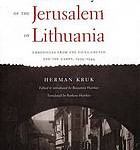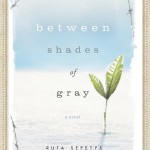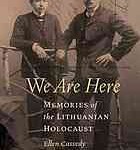A number of years ago my father gave me The Last Days of the Jerusalem of Lithuania: Chronicles from the Vilna Ghetto and the Camps, 1939-1944, an imposing 700 page work containing the journals, writings, and poems of Herman Kruk, who chronicled his time in the Vilna Ghetto before he was deported and murdered in an Estonian camp. The book haunted me from the moment I opened it; the initial poems are an eloquent testament to Kruk’s desire to bear witness for future generations:
I know I am condemned and awaiting my turn,
Although deep inside me burrows a hope for a miracle.
Drunk on the pen trembling in my hand,
I record everything for future generations:
A day will come when someone will find
The leaves of horror I write and record.
People will tear their hair in anguish,
Eyes will plunge into the sky
Unwilling to believe the horror of our times.
And then these lines will be a consolation
For future generations, which I, a prisoner,
Kept in my sight, things
I recorded, fixed faithfully…
For me it is superfluous,
For future generations I leave it as a trace.
And let it remain though I must die here
And let it show what I could not live to tell.
And I answer my neighbors:
Maybe a miracle will liberate me.
But if I must die, it must not die with me –
This book weighs heavily upon me – I feel an almost unbearably strong obligation to read it, yet I cannot get beyond the first few poems. I fear the emotional drain of what awaits me inside the book. I am astounded that his widely scattered diary pages survived the war, were collected and lovingly translated from Yiddish, and that I now have his eyewitness account in my hands. I keep it on a prominent place on my bookshelf – in a way it is an effort to assuage my guilt, but its pride of place is a constant reminder of an unfulfilled charge. So it sits there, staring me down, day after day, daring me to ensure that Kruk’s voice does not get forgotten or lost in the depths of history.
While Kruk’s chronicle of the Vilna ghetto sits in judgment on my shelf, another Lithuanian story that I should have known about, but did not, is Ruta Sepetys’ Between Shades of Gray. Although it is a best-selling, award winning young adult novel, the truth is that my introduction to Sepetys came from a mysterious tweet from a literary agent outlining Sepetys’ travel itinerary, which included a trip to Poland. I was intrigued and scrambled to learn a bit more about the author and her book. When I saw a self-description stating she was “a seeker of lost stories,” I was hooked.
I would not so much describe myself as a seeker of lost stories, but rather as a collector of story fragments. The Moshe Rynecki story is a vast mosaic of lost art, lost lives, lost country, and my own lost legacy. It is a puzzle with at once too many pieces and many pieces missing. Many pieces are missing because the details are lost in the mists of memory. There are questions that can’t be even asked because I don’t know enough context to ask them; and even if I could the people who knew the answers are no longer with us. At times the not knowing is hard and I wish I had solid answers with all that I want to know, but the truth is that war is traumatic, the Holocaust almost unimaginably so, and what remains is inevitably messy. I continue my quest for lost Moshe Rynecki paintings because I find the fragments of stories along the way to be compelling and alluring.
Similarly, Sepetys’ story is one that started with pieces — interviews with her family members, with survivors of deportations and the gulags, with psychologists and historians — but which she has seamlessly woven together, filling in the gaps to create a captivating and heart wrenching tale. Set in Lithuania in the 1940s, Between Shades of Gray opens with the deportation of Lina, a 15 year old girl. From the book’s first sentence, “They took me in my nightgown,” Lina tells her own story of how Stalin’s brutality and his ruthless efforts to “cleanse” the Baltic region directly impacted her own existence. Told in a rotating manner between first person narratives and flashbacks that offer glimpses into Lina’s middle-class life, readers learn about Soviet secret police, prison camps, forced labor, starvation, disease, and death suffered by hundreds of thousands. Sepetys skillfully navigates the complexities of the history and delivers a compelling and coherent tale in a young girl’s voice. It’s a suspenseful, harrowing, and poignant page turner.
While Septetys worked to weave a single story from a multitude of fragments, Ellen Cassedy’s We Are Here: Memories of the Lithuanian Holocaust takes a decidedly different approach. Cassedy’s book is a 21st century memoir about her efforts to become more fluent in Yiddish, to connect with her Lithuanian heritage, and to better understand Lithuanian post-war generational strategies for confronting (or in many cases, not confronting) the nation’s complicated history.
Cassedy is in difficult and dangerous waters here. She seeks clear cut answers to questions that are buried in history and are topics that both her family as well as those still living in Lithuania do not want to explore, or only want to address on their own terms. She arrives in Vilnius eager to ask questions and obtain answers, but she discovers that history is messy work. One person wants to tell her a story, but won’t allow her to ask questions. Another is hired to translate documents, but tears up what she’s brought and substitutes in documents he deems more important. Cassedy is torn between her own desire to know the truth and to have answers that explain the past, but she does not want to press and be aggressive in seeking answers about a past that is painful for loved ones, new friends, and strangers. Sorting through history can be chaotic at the best of times; and the active work of those who have a vested interest to change the tale to suit themselves or their conceptions make it vastly more difficult. Cassedy’s book is as much about the process of learning as it is about what is learned. Cassedy finds that even when the past seems immediate and tangible, as when she stands at the ghetto gate which once was home to her family, it is ephemeral enough to slip through your fingers, always remaining just out of reach.
Readers of history often want a neat beginning, middle, and end. Cassedy shows that the overarching narrative can proceed in this manner, but that it is always to some degree a construction of the author, whether purposeful or inadvertent. Legacy and heritage are complex, and involving living people complicates even as it illuminates. Adding multiple agendas and points of views can make the presentation of a simple answer or “fact” seem ever more inadequate. My take away from We are Here is writing history is not just a matter of knowing what questions to ask, but determining what we must do with the information we are given- that a degree of skepticism in pursuit of knowledge is a critical tool.
Neither the Moshe Rynecki paintings nor my legacy are Lithuanian stories, but there are parallels between what Sepetys, Cassedy, and I struggle to understand. The three of us are descendants of those impacted by the horrors of the Second World War and while the details of our family stories are decidedly different, we have all grown up in the shadow of this legacy. Sepetys and Cassedy, in very different ways, struggle to process Lithuanian history. I greatly admire both Sepetys and Cassedy who could have stood, like me, at the edge and not opened Kruk’s book to confront the tragedy inflicted upon the Lithuanian people by both the Nazis and Soviet aggressors. Instead, they both worked tirelessly to peel back the layers of time and dared to ask questions to which there are no simple answers, to write in an effort to understand the vile persecution, and to give voice to the stories for future generations.


